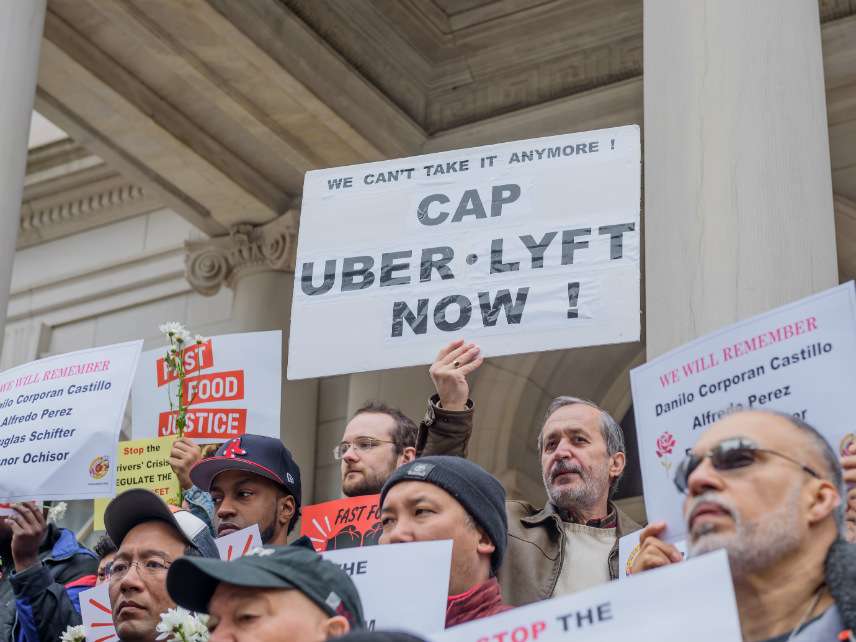New York Times Editorial Board Thinks Uber Is Too Popular, Demands Price Floors
America's paper of record demands an end to transit innovation.

The problem with ridesharing is it works too well. Or that's the thesis of an editorial this week in The New York Times.
Sure, the Times concedes, these app-based transit companies are making intracity travel easier. Ridesharing apps have "been a boon to people trying to get around town," especially those ill-served by public transit. But they also "lay waste to the livelihoods of taxi drivers and turn New York's already busy streets into glorified parking lots."
To remedy this problem, America's paper of record taps a couple ideas that have been gathering dust since the 1930s, including a price floor for rides, a minimum guaranteed fare for drivers, and subjecting ridesharing companies to the same regulations as taxis (because "it makes little sense for the city to regulate the old and new guard of for-hire cars differently when many New Yorkers use them interchangeably").
Some of these ideas are already getting traction. New York Mayor Bill de Blasio has suggested capping the number of ridesharing cars allowed in the city, while New York City Councilman Brad S. Lander (D-Brooklyn) has introduced a bill that would give the city's Taxi and Limousine Commission the power to set a price floor for ridesharing drivers and to mandate that these drivers be paid at least the same as drivers of traditional taxis.
What these politicians and editorialists are missing is that what the Times calls the "Uber problem" is evidence of the model's success.
Falling returns to taxi operators means consumers are opting for a service that better meets their needs and is offered at a lower price. Increasing traffic congestion shows that consumers are making the switch, and indeed that ridesharing is expanding the market for trips within New York City.
In other words, more people are travelling to places they want to be, and they're doing so at a lower cost. These benefits are accruing to riders because of an innovative business model that allows ridesharing companies to both route around the taxi cartel and to rapidly expand or contract the size of their fleets in response to how many people want rides at a given time. Far from welcoming this innovation, the Times and likeminded officials want to tear it all down with price floors and one-size-fits-all regulations.
Such rules will only make the city's transportation problems worse.
For starters, trying to craft regulations that treat taxi companies and Uber drivers the same because customers flit between the two services is nonsensical when their business models are so different. You might as well decide to regulate Greyhound and Southwest identically because both service the same demand for intercity travel.
The likely result—particularly given the Times' interest in protecting the taxi industry—will be to saddle rideshare companies with ill-fitting regulations that raise costs and deter them from even operating in the city.
A price floor would likely be even worse, pricing sensitive riders out of the market while failing to provide drivers with a better wage, to help the taxi industry, or even to tackle congestion.
Currently, drivers for Uber, Lyft, and other services enter or leave the market based on the price they can fetch for offering a ride, which is in turn based on the number of people demanding rides at a given time. Should the government impose a price floor on rides while changing nothing else, fewer riders will be willing to pay the higher mandated fares while more drivers will not get the hint that their services are no longer in demand.
The result will be plenty of drivers still circulating the city's roads hunting for a shrinking pool of customers, increasing congestion and competing with taxis, but without the benefit of actually taking people to and from their destination.
The only fix proposed by the Times that has any promise is congestion pricing—basically a dynamic toll that rises or falls with the number of cars on the road—and then plowing that into shoring up the city's ailing public transit system.
At the risk of having to hand back my libertarian card, I don't think there's anything wrong with asking drivers to pay more for a faster trip, then using that that money to compensate deterred motorists with better transit service that offers them a real alternative to driving. In theory, that should work in a place like New York City, and particularly Manhattan, where transit can serve as a substitute for a lot of automobile trips.
In practice, it's far from clear that the dreadfully incompetent Metropolitan Transportation Authority, which runs the city's buses and trains, would actually spend any additional revenue wisely. So even this solution has problems.
Still, points for a proposal that mimics one of the innovative elements of ridesharing—a dynamic price managing supply and demand across the road network—rather than trying to squeeze innovation out of the system altogether.
The goal should be to create more options for riders looking to get where they want go. Companies like Uber and Lyft are doing just that. Any future reforms should build on what they're doing, not regulate them out of existence.
Rent Free is a weekly newsletter from Christian Britschgi on urbanism and the fight for less regulation, more housing, more property rights, and more freedom in America's cities.

Show Comments (119)